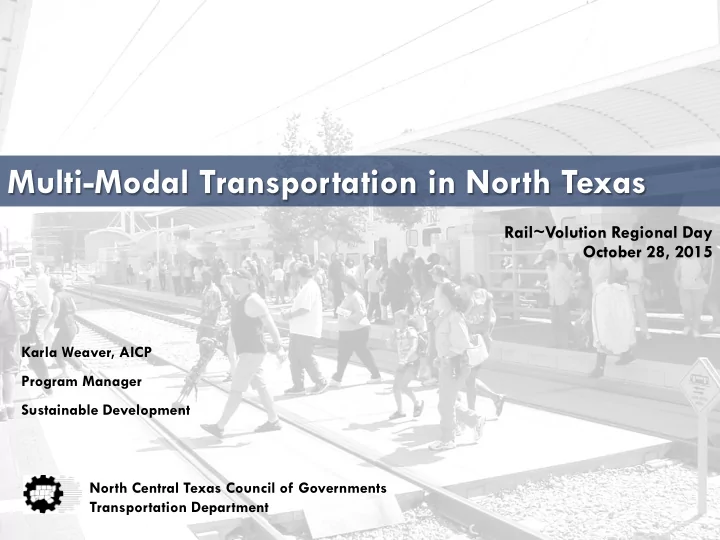

Multi-Modal Transportation in North Texas Rail~Volution Regional Day October 28, 2015 Karla Weaver, AICP Program Manager Sustainable Development North Central Texas Council of Governments Transportation Department
The North Central Texas Region 2 Fourth most populous Metropolitan Planning Area metropolitan region in US (12 counties) Population doubled over the Population: 6.7 million 2014 estimates last 30 years (3 million to 6 million) 217 cities (19 with fixed- route transit) Three main fixed-route providers 145 miles of passenger rail with 75 existing stations and approximately 13,600 bus stops Source: NCTCOG, 2015
The North Central Texas Region 3 Dallas, Tarrant, Collin, and Denton Counties • Population: 5.6 million (88% of region) • Jobs: 3.6 million (91% of region) • Forecast 2040 Population: 9.25 million Jobs: 6.1 million Source: NCTCOG, 2015
Where are the living wage jobs? 4 Example: Living Wage ~$40,000 annually Top Five Areas 1. Dallas CBD and Uptown 2. Fort Worth CBD 3. Irving’s Las Colinas Development 4. Dallas North Tollway 5. Central Expressway (Hwy 75) 100,000 Living Wage Jobs per Square Mile 1,000 Data Source: U.S. Census Longitudinal Employment-Household Dynamics (LEHD) Origin-Destination Employment Statistics (LODES), 2013. NCTCOG, 2015
Where is the affordable housing? 5 Affordable Housing: Spending less than 30% of annual household income on housing Map = Households earning under $50,000 annually who spend less than 30% of income on housing 7,000 Affordable Housing Units per Square Mile 0 Data Source: U.S. Census, American Community Survey, Block Groups, 5-year 2009 – 2013. NCTCOG, 2015
Where are the health issues concentrated? 6 Transportation Impacts on Health: • Physical Activity • Access to Goods and Services • Safety and Air Quality 100 (most risk) SocioNeeds Index (likelihood of health risk) 0 (least risk) Data Source: Healthy Communities Institute – SocioNeeds Index, 2015. NCTCOG, 2015
How well is it all connected? 7 Connections Compared by Mode Roads Transit Bikes Population 100% 51% 49% Living 100% 63% 22% Wage Jobs Affordable 100% 65% 38% Housing Units Hospitals 100% 51% 27% and Medical Data Source: NCTCOG GIS layers, DART, The T, and DCTA General Transit Feed Specification Data. NCTCOG, 2015
How well is it all connected? 8 1.4% = percent of our region commuting 2013 to work by transit 1 $12,700 = annual cost of transportation for the typical household in our region 2 2 days = time lost by average North 2035 Texas commuter each year in peak traffic 3 and $4.7 billion lost collectively to the cost of congestion 4 Congestion 45% = estimated increase in time to Level complete trips by 2035 even after an Light additional $50 billion to be spent on roadways 4 Severe 1. Census ACS 5-year 2009-2013, 2. CNT H+T Index, 3. TTI Mobility Report 2014, 4. NCTCOG Mobility Plan 2035. NCTCOG, 2015
Within one-half mile of our rail corridors: 9 Source: NCTCOG
Contact 10 Karla Weaver, AICP Program Manager kweaver@nctcog.org (817) 608-2376 North Central Texas Council of Governments nctcog.org/trans/sustdev
Recommend
More recommend